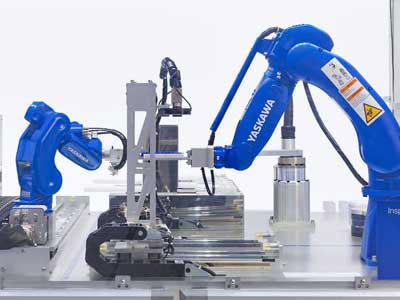Key Takeaway
The most common industrial robot is called an articulated robot. This robot resembles a human arm and is often referred to as a robotic arm or manipulator arm. Articulated robots have multiple joints, giving them several degrees of freedom. This allows them to perform a wide range of movements, making them highly versatile in industrial applications. These robots are used for tasks like welding, assembly, and material handling. Their flexibility and precision make them essential in modern manufacturing, enhancing efficiency and productivity.
Naming Conventions
Understanding how industrial robots are named can provide insights into their functionalities and applications. From articulated robots to SCARA (Selective Compliance Assembly Robot Arm) robots, each name often hints at its specific capabilities in precision assembly, welding, or material handling tasks. These names are not merely arbitrary but crafted to convey technical specifications crucial for engineers and manufacturers. This naming convention helps in quickly identifying the robot’s design and intended use, making it easier for professionals to select the right robot for specific industrial processes.

Popular Industrial Robots
Industrial robots have undergone a remarkable evolution, reflecting both technological advancements and changing industry demands. The journey began with early pioneers like the Unimate, introduced in the 1960s by George Devol and Joseph Engelberger. This groundbreaking robot marked the inception of industrial automation, primarily used in automotive assembly lines. Its impact was profound, demonstrating the potential to replace manual labor with automated precision.
As industries progressed, so did robot capabilities. The 1980s saw the rise of articulated robots, introducing greater flexibility and range of motion. Names like “Fanuc” and “ABB” became synonymous with innovation, offering robots that could perform complex tasks with unparalleled accuracy. These robots revolutionized manufacturing, enhancing efficiency and product quality across various sectors.
Fast forward to the present day, and the landscape of industrial robots has evolved once again. The advent of collaborative robots, or cobots, represents a significant shift. Unlike their predecessors, cobots are designed to work alongside humans, facilitating safer and more interactive manufacturing environments. Brands like “KUKA” with their KR AGILUS series have led this charge, integrating advanced sensors and adaptive technologies to enhance productivity while ensuring worker safety.
Historical Names and Evolution
Within the realm of industrial robotics, certain brands have not only dominated but also defined industry standards. “Fanuc,” known for its robust and reliable robots, has set benchmarks in automotive and electronics manufacturing. Their robots, such as the Fanuc R-2000iB, are revered for their speed and precision, making them indispensable in high-volume production environments.
“ABB,” on the other hand, has carved a niche with its versatile range of robots. The ABB IRB 6700 series exemplifies their commitment to efficiency and adaptability, catering to diverse applications from welding to material handling. ABB’s robots are celebrated for their modular design, which allows for easy integration into existing production lines, thereby optimizing operational workflows.
Meanwhile, “KUKA” stands out for its innovative approach to robotics. The KUKA KR AGILUS series embodies agility and intelligence, designed to handle intricate tasks with ease. These robots leverage advanced control systems and intuitive programming interfaces, empowering manufacturers to achieve new levels of precision and operational excellence.
Industry-Specific Names
In specialized sectors such as aerospace or food processing, the naming of industrial robots serves more than just a branding purpose—it encapsulates the unique functionalities and operational demands of these environments. For instance, robots destined for cleanroom settings often bear names that emphasize sterility and precision, such as “SteriBot” or “CleanArm,” highlighting their ability to maintain strict hygiene standards critical in pharmaceutical or semiconductor manufacturing.
Conversely, robots deployed in foundries or heavy industries adopt names that evoke strength and durability, such as “ForgeMaster” or “IronGuard,” reflecting their robust construction and ability to withstand extreme conditions like high temperatures and heavy loads. These industry-specific names not only differentiate the robots but also signal their suitability for particular applications, ensuring seamless integration into diverse production workflows.
Future Naming Trends
As industrial technology continues to advance, the naming conventions for robots are expected to evolve in tandem, reflecting emerging trends in connectivity, artificial intelligence (AI), and sustainability. Future robot names are likely to incorporate descriptors that underscore their advanced capabilities and functionalities.
For instance, names may include terms like “SmartBot” or “AI-Worker,” indicating integration with AI algorithms for autonomous decision-making and learning capabilities. Sustainability-focused names could feature terms like “EcoBot” or “GreenArm,” highlighting robots designed for energy efficiency and reduced environmental impact through innovative material usage or energy-saving features.
Moreover, connectivity will play a crucial role, with names such as “LinkBot” or “NetArm” suggesting seamless integration into Internet-of-Things (IoT) ecosystems, enabling real-time data exchange and remote monitoring. These names not only convey technological prowess but also assure stakeholders of enhanced operational efficiency and adaptability in dynamic manufacturing environments.
Conclusion
In conclusion, the names of industrial robots are more than just identifiers—they embody decades of engineering expertise, innovation, and industrial prowess. Whether it’s navigating the historical lineage of names or anticipating future trends, understanding these monikers is crucial for anyone entering the field of industrial automation. As you embark on your journey as an engineer, grasp the significance of these names—they are your gateway to mastering the transformative power of industrial robotics.
